Once the corn crop is in the ground and up, it’s time to see just how you and the planter faired.
It’s time for field scouting and evaluating stands, along with early herbicide applications or secondary nitrogen.
Why it matters: Though there have been many advances in planting equipment, evaluation of corn and soybean stands is still recommended by agronomists.
Read Also

Clean seed garlic promises bigger bulbs and higher returns for growers
Ontario garlic trials show clean seed outshines conventional yields, with stronger drought resilience, reduced virus risk and greater economic outcomes.
When evaluating stands, even emergence is the key to higher productivity in corn. The more uniform the stand, the less likely that plants will compete with one another.
According to Mervyn Erb, advances in equipment in the past few years have vastly improved planting depth, seed-to-seed or plant-to-plant spacing and seed singulation, to the point where double seedings and triples are harder to find.
But that doesn’t diminish the need for stand evaluation. He suggests using drainage flags to mark emergence, with a different colour for each 24-hour period.
“The monitor might say you’re hitting 98 per cent of your objective but what you don’t know is how is it emerging row-to-row-to-row,” says Erb, a certified crop advisor who runs Agri-Solve Inc. in Brucefield.
Equipment may be more sophisticated, but seed size isn’t as selective as in the past, he adds.
He knows one grower with the same hybrid but different bags, some with round 23s and others containing pdfs, or “pretty darn flats.”
Generally, the singulation on planters can handle any sized seed but the resulting variability can lead to uneven emergence, and Erb notes that blending different sizes isn’t likely to help.
Instead of mixing them up, he recommends planting one size first, then adjusting the planter. It may be more time-consuming but variability and uneven emergence isn’t always the fault of the planter.
Soybean emergence
It’s not that soybean emergence is less important, but Horst Bohner maintains there’s greater flexibility compared to corn. Individual soybean plants can come up a week or two weeks following planting due to differences in depth or moisture conditions or a micro-climate where a seed is placed.
Usually, emergence occurs within a range of seven to 21 days, yet in some instances, soybean seed can sit in cold soil and dry conditions for six weeks and still emerge.
“Since soybeans have to push the cotyledon through the soil surface, we typically see an average of 20 per cent reduction from what we planted on a seeds per acre or plants per acre basis,” adds Bohner, soybean specialist with the Ontario Ministry of Agriculture, Food and Rural Affairs.
“That’s why our seeding rates are what they are, as an added insurance factor.”

When evaluating a soybean stand, he says the minimum goal is at least 100,000 plants per acre before considering a replant. Depending on the date, that number could be as low as 90,000 or 80,000 plants, based on soil type and row-width, with seeding rates of about 160,000 as a general guideline.
For Bohner, that makes the goal roughly140,000 plants per acre to attain a 100 per cent yield index.
Timing and total package
The other significant change that Chad Garrod sees in the spring is the “total package” effect in management. Emergence is paramount in corn yet the perception is that planting windows are tighter, making crop stand evaluations more stressful.
That can have an impact on herbicide timing and weed management or be affected by equipment availability or last year’s harvest.
Spring planting is stressful, but that’s the case for everyone in the industry, including seed dealers and retailers with fertilizer and inputs.
“It’s great when you have good conditions because you can get a lot of acres through really quick,” says Garrod, Eastern Canada portfolio marketing manager for Corteva Agriscience.
“But if we have bad weather, it’s going to have a greater impact (on everyone) because our planting window has happened at the same time.”
Garrod also believes the good timing of last year’s corn harvest —and the ability of the soil to breakdown heavier residues — will have helped this year’s soybean planting and emergence.
Edited to make the article less time sensitive.















